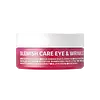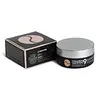What's inside
What's inside
 Key Ingredients
Key Ingredients

 Benefits
Benefits

 Concerns
Concerns

 Ingredients Side-by-side
Ingredients Side-by-side

Water
Skin ConditioningDipropylene Glycol
HumectantGlycerin
HumectantNiacinamide
Smoothing1,2-Hexanediol
Skin ConditioningChondrus Crispus Extract
Skin ConditioningRosa Damascena Flower Water
MaskingCeratonia Siliqua Gum
EmollientRosa Damascena Flower Oil
MaskingRosa Hybrid Flower
Skin ConditioningSodium Hyaluronate
HumectantSodium Acetylated Hyaluronate
HumectantHydrolyzed Hyaluronic Acid
HumectantHydrolyzed Sodium Hyaluronate
Skin ConditioningHyaluronic Acid
HumectantHydroxypropyltrimonium Hyaluronate
Potassium Hyaluronate
Skin ConditioningSodium Hyaluronate Crosspolymer
HumectantHippophae Rhamnoides Fruit Extract
Skin ConditioningRubus Idaeus Fruit Extract
AstringentRubus Fruticosus Fruit Extract
AstringentEuterpe Oleracea Fruit Extract
Vaccinium Myrtillus Fruit Extract
Skin ConditioningVaccinium Macrocarpon Fruit Extract
AstringentRibes Nigrum Fruit Extract
AstringentVaccinium Angustifolium Fruit Extract
Skin ProtectingHouttuynia Cordata Extract
Skin ConditioningCentella Asiatica Extract
CleansingCalendula Officinalis Flower Extract
MaskingScutellaria Baicalensis Root Extract
AstringentGlycyrrhiza Glabra Root Extract
BleachingGlutathione
Allantoin
Skin ConditioningBetaine
HumectantTrehalose
HumectantPanthenol
Skin ConditioningDipotassium Glycyrrhizate
HumectantAdenosine
Skin ConditioningPotassium Chloride
Sucrose
HumectantXanthan Gum
EmulsifyingCellulose Gum
Emulsion StabilisingPolyglyceryl-10 Oleate
Skin ConditioningGlyceryl Caprylate
EmollientPelargonium Graveolens Flower Oil
MaskingCitrus Aurantium Dulcis Peel Oil
MaskingCitronellol
PerfumingGeraniol
PerfumingLinalool
PerfumingCI 77491
Cosmetic ColorantWater, Dipropylene Glycol, Glycerin, Niacinamide, 1,2-Hexanediol, Chondrus Crispus Extract, Rosa Damascena Flower Water, Ceratonia Siliqua Gum, Rosa Damascena Flower Oil, Rosa Hybrid Flower, Sodium Hyaluronate, Sodium Acetylated Hyaluronate, Hydrolyzed Hyaluronic Acid, Hydrolyzed Sodium Hyaluronate, Hyaluronic Acid, Hydroxypropyltrimonium Hyaluronate, Potassium Hyaluronate, Sodium Hyaluronate Crosspolymer, Hippophae Rhamnoides Fruit Extract, Rubus Idaeus Fruit Extract, Rubus Fruticosus Fruit Extract, Euterpe Oleracea Fruit Extract, Vaccinium Myrtillus Fruit Extract, Vaccinium Macrocarpon Fruit Extract, Ribes Nigrum Fruit Extract, Vaccinium Angustifolium Fruit Extract, Houttuynia Cordata Extract, Centella Asiatica Extract, Calendula Officinalis Flower Extract, Scutellaria Baicalensis Root Extract, Glycyrrhiza Glabra Root Extract, Glutathione, Allantoin, Betaine, Trehalose, Panthenol, Dipotassium Glycyrrhizate, Adenosine, Potassium Chloride, Sucrose, Xanthan Gum, Cellulose Gum, Polyglyceryl-10 Oleate, Glyceryl Caprylate, Pelargonium Graveolens Flower Oil, Citrus Aurantium Dulcis Peel Oil, Citronellol, Geraniol, Linalool, CI 77491
Water
Skin ConditioningGlycerin
HumectantCarrageenan
Butylene Glycol
HumectantHydrolyzed Collagen
EmollientSodium Hyaluronate
HumectantHydrolyzed Hyaluronic Acid
HumectantSodium Acetylated Hyaluronate
HumectantHydroxypropyltrimonium Hyaluronate
Potassium Hyaluronate
Skin ConditioningSodium Hyaluronate Crosspolymer
HumectantHyaluronic Acid
HumectantPearl Extract
AntioxidantPolysorbate 80
EmulsifyingTocopheryl Acetate
AntioxidantUbiquinone
AntioxidantAcetyl Hexapeptide-8
HumectantCopper Tripeptide-1
Skin ConditioningOligopeptide-29
AntioxidantOligopeptide-32
AntiseborrhoeicPalmitoyl Pentapeptide-4
Skin ConditioningPalmitoyl Tripeptide-1
Skin ConditioningPalmitoyl Tetrapeptide-7
Skin ConditioningGlyceryl Polymethacrylate
Propylene Glycol
HumectantPalmitoyl Oligopeptide
CleansingPalmitoyl Tripeptide-5
Skin ConditioningPropanediol
SolventPentylene Glycol
Skin ConditioningCocos Nucifera Fruit Extract
EmollientPinus Sylvestris Leaf Extract
TonicRicinus Communis Seed Oil
MaskingButyrospermum Parkii Butter
Skin ConditioningBetaine
HumectantAllantoin
Skin ConditioningDipotassium Glycyrrhizate
HumectantCeratonia Siliqua Gum
EmollientSucrose
HumectantCyamopsis Tetragonoloba Gum
Emulsion StabilisingCellulose Gum
Emulsion StabilisingPotassium Chloride
Calcium Chloride
AstringentCalcium Lactate
AstringentCaprylic/Capric Triglyceride
MaskingSorbitan Caprylate
EmulsifyingPEG-60 Hydrogenated Castor Oil
EmulsifyingDiamond Powder
AbrasiveTitanium Dioxide
Cosmetic ColorantOleth-10
EmulsifyingTriethoxycaprylylsilane
Polysorbate 60
EmulsifyingSimethicone
EmollientMethyl Methacrylate Crosspolymer
Aluminum Hydroxide
EmollientSynthetic Fluorphlogopite
Arginine
MaskingDisodium EDTA
Chlorphenesin
AntimicrobialEthyl Hexanediol
Solvent1,2-Hexanediol
Skin ConditioningEthylhexylglycerin
Skin ConditioningParfum
MaskingWater, Glycerin, Carrageenan, Butylene Glycol, Hydrolyzed Collagen, Sodium Hyaluronate, Hydrolyzed Hyaluronic Acid, Sodium Acetylated Hyaluronate, Hydroxypropyltrimonium Hyaluronate, Potassium Hyaluronate, Sodium Hyaluronate Crosspolymer, Hyaluronic Acid, Pearl Extract, Polysorbate 80, Tocopheryl Acetate, Ubiquinone, Acetyl Hexapeptide-8, Copper Tripeptide-1, Oligopeptide-29, Oligopeptide-32, Palmitoyl Pentapeptide-4, Palmitoyl Tripeptide-1, Palmitoyl Tetrapeptide-7, Glyceryl Polymethacrylate, Propylene Glycol, Palmitoyl Oligopeptide, Palmitoyl Tripeptide-5, Propanediol, Pentylene Glycol, Cocos Nucifera Fruit Extract, Pinus Sylvestris Leaf Extract, Ricinus Communis Seed Oil, Butyrospermum Parkii Butter, Betaine, Allantoin, Dipotassium Glycyrrhizate, Ceratonia Siliqua Gum, Sucrose, Cyamopsis Tetragonoloba Gum, Cellulose Gum, Potassium Chloride, Calcium Chloride, Calcium Lactate, Caprylic/Capric Triglyceride, Sorbitan Caprylate, PEG-60 Hydrogenated Castor Oil, Diamond Powder, Titanium Dioxide, Oleth-10, Triethoxycaprylylsilane, Polysorbate 60, Simethicone, Methyl Methacrylate Crosspolymer, Aluminum Hydroxide, Synthetic Fluorphlogopite, Arginine, Disodium EDTA, Chlorphenesin, Ethyl Hexanediol, 1,2-Hexanediol, Ethylhexylglycerin, Parfum
Ingredients Explained
These ingredients are found in both products.
Ingredients higher up in an ingredient list are typically present in a larger amount.
1,2-Hexanediol is a synthetic liquid and another multi-functional powerhouse.
It is a:
- Humectant, drawing moisture into the skin
- Emollient, helping to soften skin
- Solvent, dispersing and stabilizing formulas
- Preservative booster, enhancing the antimicrobial activity of other preservatives
Allantoin is a soothing ingredient known for its protective and moisturizingg properties. Because of this, it is often added to products with strong active ingredients.
Studies show higher concentrations of this ingredient can promote wound healing.
Though it can be derived from the comfrey plant, allantoin is produced synthetically for cosmetic products to ensure purity.
Learn more about AllantoinBetaine is a common humectant (a substance that promotes retention of moisture). It's known to be gentle on the skin and can help balance hydration.
This ingredient is best for improving hydration and soothing irritated skin. Studies also show it helps even out skin tone.
Fun fact: Betaine is naturally created in the skin and body. The kind found within cosmetic products can be either plant-derived or synthetic.
Another name for betaine is trimethylglycine.
Learn more about BetaineCellulose Gum is a water-soluble polymer that comes from cellulose. It is used to change the texture of a product and to help stabilize emulsions.
As an emulsifier, cellulose gum specifically thicken the texture of water-based products.
This ingredient is considered hypoallergenic and non-toxic. Cellulose Gum can be found in cosmetics, food, and other household goods such as paper products.
Learn more about Cellulose GumCeratonia Siliqua Gum is extracted from the seeds of the carob tree. You might know this ingredient as Carob Gum or Locust Bean Gum. It is used to stabilize other ingredients and improve the texture of products.
Carob gum is made up of long-chain polysaccharides. This makes it a natural thickener.
Yes! This ingredient comes from the seeds of a tree. The name 'Locust Bean Gum' can be misleading.
Learn more about Ceratonia Siliqua GumDipotassium Glycyrrhizate comes from licorice root.
Extracts of licorice have demonstrated to have antibacterial, anti‐inflammatory, antiviral, antioxidant properties.
One component, glabridin, has extra potent antioxidant and soothing properties. It has also been found to block pigmentation from UVB rays in guinea pigs.
Licorice Root also contains a flavonoid. Flavonoids are a natural substance from in plants. Flavonoids also have antioxidant properties.
Another component, glycyrrhizin, has been found to have anti-inflammatory and antimicrobial benefits. This may make licorice root extract effective at treating acne. However, more research is needed to support this.
Liquiritin is one of the flavone compounds found in licorice. It has been found to help lighten skin by preventing tyrosinase from reacting with tyrosine. When the two react, protein is converted to melanin. Melanin is the substance in your body that gives your features pigmentation.
Licorice root is native to Southern Europe and Asia. It has been used in traditional Chinese medicine to help with respiratory issues.
Learn more about Dipotassium GlycyrrhizateGlycerin is already naturally found in your skin. It helps moisturize and protect your skin.
A study from 2016 found glycerin to be more effective as a humectant than AHAs and hyaluronic acid.
As a humectant, it helps the skin stay hydrated by pulling moisture to your skin. The low molecular weight of glycerin allows it to pull moisture into the deeper layers of your skin.
Hydrated skin improves your skin barrier; Your skin barrier helps protect against irritants and bacteria.
Glycerin has also been found to have antimicrobial and antiviral properties. Due to these properties, glycerin is often used in wound and burn treatments.
In cosmetics, glycerin is usually derived from plants such as soybean or palm. However, it can also be sourced from animals, such as tallow or animal fat.
This ingredient is organic, colorless, odorless, and non-toxic.
Glycerin is the name for this ingredient in American English. British English uses Glycerol/Glycerine.
Learn more about GlycerinHyaluronic acid is naturally found in healthy skin. It is a humectant, meaning it draws moisture to your skin.
This ingredient helps hydrate, soothe, and protect the skin.
What makes hyaluronic acid so hydrating? It has the capacity to bind or hold large amounts of water.
Fun fact: It is already naturally found in our bodies, such as the fluids of our eyes and our joints.
Studies find this ingredient to have anti-inflammatory and anti-microbial properties. This can help speed up wound-healing.
Hyaluronic acid can be irritating if the molecule has a low-molecular weight, or if the molecules are small.
One study found low-molecular weight hyaluronic acid to be pro-inflammatory, meaning some people may experience irritation. This is because our bodies use hyaluronic acid in the wound-healing process to signal to our bodies, via irritation, that something needs healing.
The same study found high-molecular weight hyaluronic acid to be anti-inflammatory.
These are some other common types of Hyaluronic Acid:
Learn more about Hyaluronic AcidHydrolyzed Hyaluronic Acid is a form of hyaluronic acid. It is created by the hydrolysis of hyaluronic acid with a high molecular weight. Once created, Hydrolyzed Hyaluronic Acid has a low molecular weight.
Low molecular weight HA has been shown to hydrate and increase elasticity of the skin. Increasing elasticity is also associated with reduction of wrinkle depth.
One study found topical low molecular weight hyaluronic acid may be considered for the treatment of rosacea in the adult population. However, we always recommend speaking with a professional about your skin concerns.
Hyaluronic acids are a humectant. This means they draw moisture from the air. Hyaluronic acids help moisturize, soothe, and protect the skin.
Read more about other common forms of hyaluronic acid:
Learn more about Hydrolyzed Hyaluronic AcidThis form of hyaluronic acid is produced through fermentation.
According to a manufacturer, it has a positive charge by ionic binding to help moisturize and give hair a smooth feel. This is why you'll find this ingredient in shampoos and body washes.
Potassium Chloride can be bad for oily skin and be bad for acne prone skin.
Potassium hyaluronate (PH) is a salt form of hyaluronic acid and has similar skin hydrating benefits.
Similar to hyaluronic acid, PH is able to draw and hold moisture to your skin. This helps keep skin soft and hydrated.
Fun fact: PH is used in eye drops and injectable treatments for joint disorders. It has lubricating and tissue-repair properties.
Learn more about Potassium HyaluronateSodium Acetylated Hyaluronate is a type of Hyaluronic Acid.
Hyaluronic Acids help moisturize, soothe, and protect the skin.
Read about common types of Hyaluronic Acid here:
Sodium Hyaluronate
Hydrolyzed Hyaluronic Acid
Hyaluronic Acid
Sodium Hyaluronate is hyaluronic acid's salt form. It is commonly derived from the sodium salt of hyaluronic acid.
Like hyaluronic acid, it is great at holding water and acts as a humectant. This makes it a great skin hydrating ingredient.
Sodium Hyaluronate is naturally occurring in our bodies and is mostly found in eye fluid and joints.
These are some other common types of Hyaluronic Acid:
Learn more about Sodium HyaluronateSodium Hyaluronate Crosspolymer is a type of hyaluronic acid. In fact, it is modified version of hyaluronic acid.
The structure of Sodium Hyaluronate Crosspolymer allows it to stay in the skin's top layer for a longer period of time. This allows for even more hydration and humectant action than hyaluronic acid.
These are some other common types of Hyaluronic Acid:
Learn more about Sodium Hyaluronate CrosspolymerSucrose is a natural sugar found in fruits, vegetables, and nuts. It is the main constituent of white sugar.
In skincare, sucrose is a humectant and can be a mild exfoliant.
Sucrose is hydrophilic, meaning it attracts water. This makes it an effective humectant and helps hydrate the skin.
Studies show sugars may worsen acne-prone skin due to it disrupting the skin's natural biome. We recommend speaking with a professional if you have any concerns.
In some products such as body scrubs, sucrose is used as an gentle exfoliant.
The term 'sucrose' comes from the french word for sugar, 'sucre'.
Learn more about SucroseWater. It's the most common cosmetic ingredient of all. You'll usually see it at the top of ingredient lists, meaning that it makes up the largest part of the product.
So why is it so popular? Water most often acts as a solvent - this means that it helps dissolve other ingredients into the formulation.
You'll also recognize water as that liquid we all need to stay alive. If you see this, drink a glass of water. Stay hydrated!
Learn more about Water